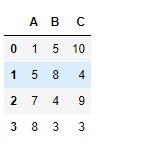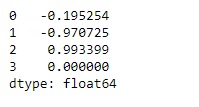Python是进行数据分析的一种出色语言,主要是因为以数据为中心的python软件包具有奇妙的生态系统。 Pandas是其中的一种,使导入和分析数据更加容易。
Pandas dataframe.corrwith()用于计算两个DataFrame对象的行或列之间的成对相关。如果两个 DataFrame 对象的形状不同,则对应的相关值将为NaN值。
用法: DataFrame.count(axis=0, level=None, numeric_only=False)
参数:
other: DataFrame
axis:0或“索引”用于按列计算,1或“列”用于按行计算
drop:从结果中删除缺少的索引,默认返回所有的并集
返回:相关:系列
注意:变量与自身的相关性为1。
范例1:采用corrwith()函数查找沿行轴的两个 DataFrame 对象之间的相关性
# importing pandas as pd
import pandas as pd
# Creating the first dataframe
df1 = pd.DataFrame({"A":[1, 5, 7, 8],
"B":[5, 8, 4, 3],
"C":[10, 4, 9, 3]})
# Creating the second dataframe
df2 = pd.DataFrame({"A":[5, 3, 6, 4],
"B":[11, 2, 4, 3],
"C":[4, 3, 8, 5]})
# Print the first dataframe
print(df1, "\n")
# Print the second dataframe
print(df2)

现在,沿着行轴找到两个数据帧的列之间的相关性。
# To find the correlation among the
# columns of df1 and df2 along the row axis
df1.corrwith(df2, axis = 0)输出:

输出序列分别包含两个 DataFrame 对象的三列之间的相关性。
范例2:采用corrwith()函数查找沿列轴的两个 DataFrame 对象之间的相关性
# importing pandas as pd
import pandas as pd
# Creating the first dataframe
df1 = pd.DataFrame({"A":[1, 5, 7, 8],
"B":[5, 8, 4, 3],
"C":[10, 4, 9, 3]})
# Creating the second dataframe
df2 = pd.DataFrame({"A":[5, 3, 6, 4],
"B":[11, 2, 4, 3],
"C":[4, 3, 8, 5]})
# To find the correlation among the
# columns of df1 and df2 along the column axis
df1.corrwith(df2, axis = 1)输出:

输出序列分别包含两个 DataFrame 对象的四行之间的相关性。
相关用法
- Python pandas.map()用法及代码示例
- Python Pandas Series.str.len()用法及代码示例
- Python Pandas.factorize()用法及代码示例
- Python Pandas TimedeltaIndex.name用法及代码示例
- Python Pandas dataframe.ne()用法及代码示例
- Python Pandas Series.between()用法及代码示例
- Python Pandas DataFrame.where()用法及代码示例
- Python Pandas Series.add()用法及代码示例
- Python Pandas.pivot_table()用法及代码示例
- Python Pandas Series.mod()用法及代码示例
- Python Pandas Dataframe.at[ ]用法及代码示例
- Python Pandas Dataframe.iat[ ]用法及代码示例
- Python Pandas.pivot()用法及代码示例
- Python Pandas dataframe.mul()用法及代码示例
- Python Pandas.melt()用法及代码示例
注:本文由纯净天空筛选整理自Shubham__Ranjan大神的英文原创作品 Python | Pandas dataframe.corrwith()。非经特殊声明,原始代码版权归原作者所有,本译文未经允许或授权,请勿转载或复制。
